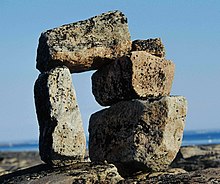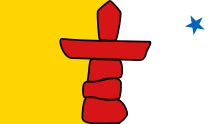Inuksuk
Literally, the Inuktitut word Inuksuk (in dialect also Inukshuk ; Greenlandic Inussuk ; plural Inuksuit ) means "like a person". The Eskimos understand it to be "an object that can take on tasks instead of a person" (non-Eskimos are also familiar with objects with such a substitute function from everyday life, such as traffic lights that replace the traffic-regulating police officer, signposts or scarecrows). Since the Eskimos had no script until the 19th century, the Inuksuit became a kind of character in the landscape. Like the myths and legends passed down through storytelling, they preserved knowledge and passed it on from generation to generation.
Historical information
Inuksuit are figurative stone structures layered on top of and next to each other, overgrown with mostly ancient lichen. It is not uncommon for them to be centuries old and then venerated by the Eskimos as inherited symbols of their ancestors. Knowledgeable elderly Eskimos ( Elders ) report: “Many Inuksuit were established by our ancestors (ie people of the Thule culture , around 1000 to 1800 AD). But others are much older; they come from the people who prepared the land for our ancestors, the Tunit (as the Eskimos call the people of the Dorset culture , around 500 BC to 1000 AD). But today's Eskimos still set up Inuksuit at landscape points that they want to mark for various reasons. "
The age of the individual Inuksuit cannot be given with any degree of reliability. The climatic and local environmental conditions in the Arctic are too different for that. Some Inuksuit are also made of rock on which lichen cannot colonize, which is why they look much younger than they are. Sometimes a microclimate develops around individual Inuksuit , which (not infrequently together with guano separated by birds ) promotes the growth of higher plant species at the foot of the Inuksuks.
Inuksuit's duties
The reasons that led to the construction of Inuksuit have hardly changed over the centuries until today. Like the cairns of other cultures, Inuksuit travelers served as signposts, were landmarks to find supplies, warnings about dangerous places and reminders of places where unusual things had happened. At the time when the Eskimos still hunted with bows and arrows, the Inuksuit had an important function in the hunt for caribou: The animals were guided by these human-like figures in the direction where the hunters were camouflaged and where they were now waiting for easy prey . A site called Tukilik near Nettling Lake in western Baffin Island is a caribou hunting site with more than 200 inuksuk. It is assumed that hunters waited there between the setting of the stones for the game, which, confused by the stones, did not notice the people or did so too late. Inuksuit were therefore useful for survival in the inhospitable Arctic for very pragmatic reasons. In addition, individual Inuksuit are known to have had spiritual effects, but little is known about their mythical meaning in the "old days". In general, Inuksuit are monuments to the knowledge, thoughts and actions of people of the past.
The Inuksuk share a tradition with menhirs and the deer stones of the Mongols. They serve the collective memory of real or mythological people and consciously change the landscape by setting human symbols. The size and weight of many of the stones require the cooperation of many people, so that the setting of the stones has a ritual, ceremonial and group-related character.
In the open, tree-free environment, characterized only by gentle landscape forms, the builders identify with the erect stones and thus create their place in the landscape. They build their own world through collective work.
Both the character as a monument and the semantic meaning of the stone figures are endangered because more and more modern stone settings are being set up by visitors to the regions who are not culturally foreign. The rangers of nature reserves point out that the construction of new stone figures in areas with prehistoric Inuksuk endanger the function and the landscape.
Shapes and designs
Inuksuit have a variety of shapes and forms, the construction of which is based on three basic patterns of stones: more or less round boulders that can be piled up to form pyramidal or cone-like hills, brick-shaped flat stones that are put together and stacked suitable for building slender structures, and expressive ones larger boulders that often act on their own. Most of the time, however, all three rock forms were carefully selected and put together; Occasionally even animal bones and antlers were built in or animal skulls were placed on top.
The different forms of Inuksuit did not come about by chance; rather, they were placed in the landscape as a kind of writing. It therefore seems logical that the Eskimos have often given Inuksuit names or designations that give general advice - such as “Be careful!” Or “Dangerous place!” Or “Go this way!” - and their meaning is immediately apparent derived from their external shape.
Inuksuit basically show four characteristic basic structures:
- individually upright boulders as a reminder ( Nalunaikkutaq , literally "one who picks up mental mess"),
- lying arrow-shaped pointers as directional pointers ( Tikkuuti , literally "compass needle", and Turaarut , "which shows the direction of destination"),
- high pyramidal piles of round stones as features that can be seen from afar ( Inuksummarik or Inuksukjuaq , "large Inuksuk")
- and more individual stone structures that convey certain messages, give clues or serve hunting purposes.
A so-called inunnguaq proves to be particularly impressive for the viewer . It is a stone figure with a head, torso, arms and legs "like a human figure". If this structure is also commonly assigned to the Inuksuit as the fifth form, yes, mostly as a "classic" Inuksuk (which recently often adorns prominent points of settlements and even the flag of the Inuit territory Nunavut introduced in 1999 ), it is when the definition is applied more precisely not a real Inuksuk. This stone structure does not act instead of a person, but rather represents a human figure like a sculpture. The first Inunnguat (plural of Inunnguaq ) were erected barely more than a hundred years ago. They are said to have served at the time to indicate to the whalers that Eskimos were nearby. Your task may also have been to simply thank the country, "our country" (in Inuktitut Nunavut ), for opening up to the Eskimos with rich hunting prey.
Inuksuk as the logo of the 2010 Olympic Winter Games
An Inuksuk also serves as the logo of the 2010 Winter Olympics in Vancouver, Canada. The logo of the games, designed in 2005, is called Ilaanaq (Inuktitut for "friend"). A similar Inuksuk has been on English Bay Beach since Expo 86 .
literature
- Ansgar Walk: How the sun and moon came to the sky. Pendragon Verlag, Bielefeld 2003 ISBN 3-934872-41-7
- Norman Hallendy: Inuksuit - Silent Messengers of the Arctic. Douglas & McIntyre, Vancouver 2000 ISBN 1-55054-778-X
- Norman Hallendy: Tukiliit: the stone people who live in the wind. University of Alaska Press 2009
- ARBOS - Society for Music and Theater : Inukshuk - the arctic art & music project. edition selene, Vienna 1999 ISBN 3-85266-126-9
- Mary Wallace: The Inuksuk Book. Greey de Pencier Books, Toronto 1999 ISBN 1-895688-90-6
- William W. Fitzhugh: Mongolia Deer Stones, European Menhirs , and Canadian Arctic Inuksuit: Collective Memory and the Function of Northern Monument Tradition. In: Journal of Archaeological Method and Theory, Vol. 24, H. 1, 2017, pp. 149-187
Web links
- "Inukshuk. Mascots made of stone ” , FAZ , February 18, 2010, with pictures
- Inuksuk ( English, French ) In: The Canadian Encyclopedia .
- Des lieux à respecter , French, optionally in English: Places of Power - Inuksuit (click on EN above right), from Canada's National Museum of History and Society





